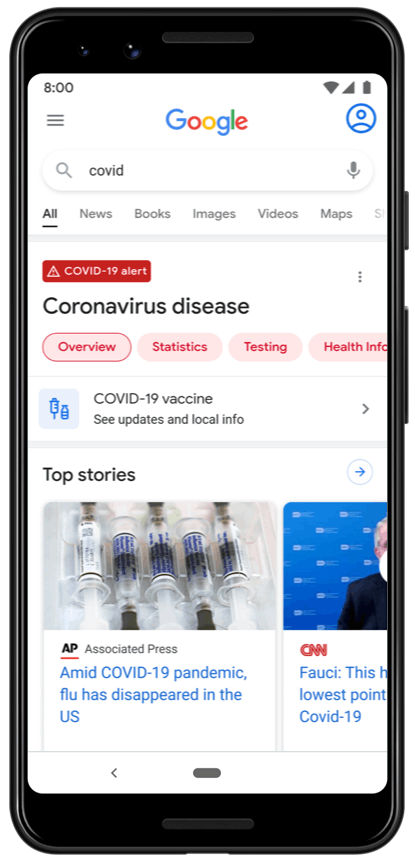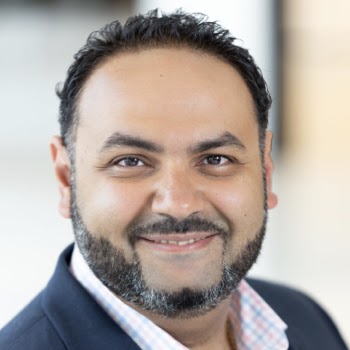30-second summary:
- Google recently rolled out the “Full Coverage” feature for mobile SERPs
- Will this impact SEO traffic for news sites, SEO best practices, and content strategies?
- Here’s what in-house SEOs from The LA Times, New York Times, Conde Nast, and prominent agency-side SEOs foresee
Google’s “Full Coverage” update rolled out earlier this month – but what does it really mean for news-SEOs? In-house SEOs from The LA Times, New York Times, Conde Nast, and prominent agency-side SEOs weigh in.
As a news-SEO person myself, I was eager to get my peers’ opinions on:
- If this feature will result in greater SEO traffic for news sites?
- If editorial SEO best practices and content strategies will evolve because of it?
- If it will result in closer working relationships between SEO and editorial teams?
- Or, will everything remain “business as usual”?
ICYMI: Google’s new, “Full Coverage” feature in mobile search
Google added the “full coverage” feature to its mobile search functionality earlier this month – with the aim of making it easier for users to explore content related to developing news stories from a diverse set of publishers, perspectives, and media slants.
Just below the “Top Stories” carousel, users will now begin seeing the option to tap into “Full Coverage”/“More news on…” for developing news stories. The news stories on this page will be organized in a variety of sub-news topics (versus one running list of stories like we’re used to seeing), such as:
- Top news
- Local news
- Beyond the headlines, and more
Take a look at in-action, here:

Source: Google
While the concept of Google “Full Coverage” was developed back in 2018, it pertained strictly to the Google News site and app. The technology, temporal co-locality, works by mapping the relationships between entities – and understanding the people, places, and things in a story right as it evolves. And then, organizes it around storylines all in real-time to provide “full coverage” on the topic searched for.
The launch of Google’s new “Full Coverage” feature in mobile search, specifically, is exciting because it takes its technology a step further; able to detect long-running news stories that span many days, like the Super Bowl, to many weeks or months like the pandemic to serve to users. The feature is currently available to English speakers in the U.S. and will be rolled out to additional languages and locations over the next few months.
What five news-SEO experts think about “Full Coverage” in mobile search

1. Lily Ray, Senior Director, SEO & Head of Organic Research at Path Interactive
Lily Ray is a Senior SEO Director at Path Interactive in New York. She’s a prominent voice within the SEO community (with +15K followers on Twitter), and has been nominated for multiple search marketing awards throughout her career. She is well known for her E-A-T expertise. Here’s what she had to say:
“Full Coverage appears to be another new tool in Google’s arsenal for displaying a diversity of perspectives and viewpoints on recent news and events. It’s a good thing for publisher sites because it represents another opportunity to have news content surfaced organically. It may also serve as a way for niche or local publishers to gain more visibility in organic search, since Google is specifically aiming to show a broader range of viewpoints that may not always come across with the major publications.
Hopefully, Google will allow us to be able to monitor the performance of Full Coverage via either Search Console or Google Analytics, so we can segment out how our articles do in this area compared to in other areas of search.”

2. Louisa Frahm, SEO Editor at The LA Times
Louisa Frahm currently serves as the SEO Editor at the Los Angeles Times and is also pursuing a master’s degree in communication management at the University of Southern California. Prior to the LA Times, Frahm was an SEO strategist at other high-profile digital publications including Entertainment Weekly, People Magazine, TMZ, Yahoo!, and E! Online. Here’s her take:
“I’ve always liked that element of Google News. It taps into readers (like me!) who are consistently hungry for more information.
Working in the journalism field, I’m always in favor of readers utilizing a diverse array of news sources. I’m glad that this new update will tap into that. I’m interested to see which stories will fall into the “develop over a period of time” criteria. I could see it working well for extended themes like COVID-19, but big breakout themes like Harry and Meghan could also potentially fit that bill.
A wide variety of story topics have resulted from that Oprah interview, and fresh angles keep flowing in! As we’re in the thick of 2021 awards season, I could also see the Golden Globes, Grammys, and Oscars playing into this with their respective news cycles before, during, and after the events.
The long-term aspect of this update inspires me to request more updates from writers on recurring themes, so we can connect with the types of topics this particular feature likes. Though pure breaking news stories with short traffic life cycles will always be important for news SEO, this feature reinforces the additional importance of more evergreen long-term content within a publisher’s content strategy.
I could see this update providing a traffic boost, since it provides one more way for stories to get in front of readers. We always want as many eyeballs as possible on our content. Happy to add one more element to my news SEO tool kit. Google always keeps us on our toes!”

3. Barry Adams, Founder of Polemic Digital
Barry Adams is the founder of SEO consultancy, Polemic Digital. He has earned numerous search marketing awards throughout his career and has also spoken at several industry conferences. His company has helped news and publishing companies such as – The Guardian, The Sun, FOX News, and Tech Radar to name a few. This is his opinion:
“The introduction of Full Coverage directly into search results will theoretically mean there’s one less click for users to make when trying to find the full breadth of reporting on a news topic.
Whether this actually results in significantly more traffic for publishers is doubtful. The users who are interested in reading a broad range of sources on a news story will already have adopted such click behaviour via the news tab or directly through Google News.
This removal of one layer of friction between the SERP and a larger number of news stories seems more intended as a way for Google to emphasize its commitment to showing news from all kinds of publishers – the fact remains that the initial Top Stories box is where the vast majority of clicks happen. This Full Coverage option won’t change that.”

4. John Shehata, Global VP of Audience Development Strategy at Conde Nast, Founder of NewzDash News SEO
John Shehata is the Global VP of Audience Development Strategy at Conde Nast, the media company known for brands such as – Architectural Digest, Allure, Vanity Fair, and Vogue. He’s also the founder of NewzDash News SEO – a News & Editorial SEO tool that helps publishers and news sites boost their visibility and traffic in Google Search. This is his opinion:
“Google has been surfacing more news stories on their SERPs over the past few years, first Top Stories were two-three links then it became a 10-link carousel. Google then started grouping related stories together expanding Top Stories carousel from one to three featuring up 30 news stories. They also introduced local news carousels for some local queries, [and now, this new feature]. It is obvious that Google keeps testing with different formats when it comes to news. One of our top news trends and prediction for 2021 is Google will continue to introduce multiple and different formats in the SERPs beyond Top Stories article formats.
As of the impact on traffic back to publishers, it is a bit early to predict but I do not expect much boost in traffic. Do not get more wrong, this feature provides more chances for more publishers to be seen, the question is how many search users will click. And if users click, Google surfaces over 50 news links plus tweets which makes it even more competitive for publishers to get clicks back to their stories.
I did some quick analysis back in July of last year When Google Search Console started providing News tab data. I found that News Impressions are less than five percent of total web impressions. Not quite sure how is the new “Full Coverage” feature CTR will be and how many users will click! The “full coverage” link placement is better than the tabs, so we might see higher CTR.”

5. Claudio Cabrera, Deputy Audience Director, News SEO at The New York Times
Claudio Cabrera serves as the Deputy Audience Director of News SEO at the New York Times. He is an award-winning audience development expert, journalist, and educator. Prior to working at The New York Times, he was Director of Social and Search strategy at CBS Local. Here are his thoughts:
“It can be looked at in so many ways. Some brands will look at it as an opportunity to gain more visibility while some will feel their strong foothold may be lost. I think it just encourages better journalism and even better SEO because it forces us to think outside of our playbooks and adjust on some level to what we’re seeing Google provide users.
From a site traffic perspective, I can’t really comment on whether this has affected us or not but I do know there are so many other areas where sites have done serious research and testing into like Discover where audiences can grow and be picked up if you do see a drop-off. I don’t think the best practices of SEO change too much but I think the relationship between search experts and editors deepens and becomes even closer due to the changes in the algo.”
Conclusion
Google’s new “Full Coverage” feature in mobile search rolled out earlier this month and is an extension of the full coverage function developed for Google News back in 2018. The aim of this new feature is to help users gain a holistic understanding of complex news stories as they develop – by organizing editorial content in such a way that it goes beyond the top headlines and media outlets. In essence, giving users the “full coverage” of the event.
News-SEO experts seem to be in agreement that this new feature will make it simpler for users to explore – and gain a holistic understanding of – trending news stories. As far as what this new feature means for SEO traffic and strategy, experts can only speculate until more developing news stories emerge and we can analyze impact.
Elizabeth Lefelstein is an SEO consultant based in Los Angeles, California. She’s worked with a variety of high-profile brands throughout her career and is passionate about technical SEO, editorial SEO, and blogging. She can be found on LinkedIn and Twitter @lefelstein.
The post What five news-SEO experts make of Google’s new, “Full Coverage” feature in mobile search results appeared first on Search Engine Watch.



